EAS Publications
As well as the formal publications listed below, we also produce short leaflets explaining our latest work and discoveries, usually available on-site during our public events and at our monthly lecture meetings (details above), available at cost-price.
Copies of our excavation and research reports are held by the Enfield Museum Service (enfield.museum.service@enfield.gov.uk).
A selection of recent exavation reports can be downloaded from here.
In Print
Elsyng: Enfield's Lost Palace Revealed
Neil & John Pinchbeck
£4.91 inc. p&p (uk delivery)
69 pages, A4. Colour illustrations throughout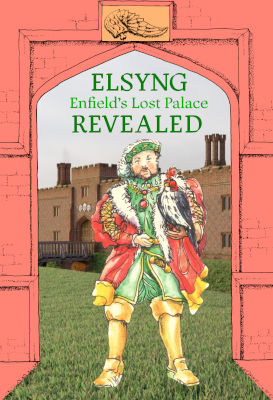
- Where did Henry VIII's only son Edward hear of his father's death and know he had become king?
- Where did Catherine Parr, sixth wife of Henry VIII, spend Christmas 1546?
- What would it have been like to be Katherine Ashley, lady-in-waiting to Princess Elizabeth, later queen Elizabeth I?
- Forty Hall in Enfield is a grand house, but did you know a much grander Royal Palace stood in its grounds until the 1650s?
With a foreword by Dr. Tracy Borman, Joint Curator of Historic Royal Palaces, Elsyng: Enfield's Lost Palace Revealed is a comprehensive introduction to Elsyng palace, its history and archaeology.
John and Neil Pinchbeck have taken part in every archaeological dig at Elsyng since 2005 and are very pleased to be named co-authors of "Monarchs, Courtiers and Technocrats; Elsyng Palace, Enfield: Place and People" with principal author Dr. Martin J. Dearne (available below).
Martin's book is the complete academic account of all the known historical sources for Elsyng and detailed account of all the archaeology which has taken place there since the 1960s. The books are very much companion volumes, Martin's book being the core reference source for Neil and John's. They are very grateful to Martin for his editorial contribution to their book.
Both books are published by Enfield Archaeological Society and were produced with a National Lottery Heritage grant administered by the London Borough of Enfield with additional funding from the Enfield Society. "Elsyng Revealed" was the Enfield Archaeological Society's project in a programme of projects entitled "Stories of Enfield" which ran from September 2021 until 1st. October 2022.
The climax of this book centres on the archaeological dig and associated activities which took place at the Elsyng palace site in July 2022. As often happens with archaeology, as well as answering questions, many more were raised. We shall be back digging to find out the answers, in 2023 and probably for many seasons to come...
Why not join us?
For delivery outside the UK, please contact chairman before ordering.
Alternatively, send a cheque payable to "The Enfield Archaeological Society" together with your postal address to:
Enfield Archaeological SocietyIan K. Jones
18 Corby Crescent
Enfield
Middlesex
EN2 7JT

Monarchs, Courtiers and Technocrats; Elsyng Palace, Enfield: Place and People
The Documentary and Archaeological Evidence for a Fifteenth to Seventeenth Century Courtier’s House and Tudor and Stuart Royal Palace; and for the Lives of its Owners and Households
Martin J. Dearne with John Pinchbeck and Neil Pinchbeck and contributions by Paul Drury and Ian K. Jones£25.00 inc. p&p (uk delivery)
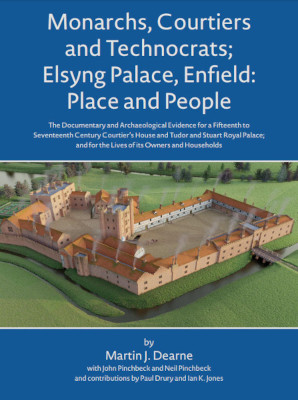
This volume (336 Pages; 85 Figures; 74 Plates) is both an historical study and an archaeological report and has been published with generous grants from both the Enfield Society and the National Lottery Heritage Fund/Enfield Council’s "Stories of Enfield" initiative.
Based on many years of research into original Medieval, and particularly Tudor and later, documents it traces the genesis and development of two Enfield manors and of the large and impressive house and eventually royal palace that lay in one and took its name at least from the other.
It examines in detail the lives of its first successive aristocratic or technocratic owners, the Tiptoft family (including the Earl of Worcester), Sir Thomas Lovell and the Earl of Rutland; and studies the households of the latter two.
From 1539 a royal palace, it charts its fortunes as one of the homes of the future Edward VI and Elizabeth I; then as one of the sovereigns’ stopping points on royal progresses under Elizabeth and James I; and finally as a home for court favourites like the Earl of Montgomery and Pembroke, before the latter bought it from the crown.
It also publishes in detail 16 years of excavations on the outer court of the palace, including the complete excavation of one service range featuring a well preserved sunken furnace, a double moat, garderobe chutes and projecting towers.
Utilising aerial photographic and LiDAR evidence as well as early Tudor inventories it seeks to reconstruct both the palace complex and its wider environs including a large Stuart parterre garden and a partially excavated brick burning clamp.
A full finds report includes usefully stratified pottery groups from the palace’s demolition in c.1660, a group of decorated Frechen Bartmann ware vessels and a range of metal and glass finds as well as building materials and faunal evidence.
An accompanying CD presents and evaluates the previously only briefly published findings of excavations and watching briefs in the 1960s which revealed probable elements of the royal apartments including projecting towers surviving to a considerable height and very large intact palace drains.
The CD also publishes full transcripts of 53 original documents relating to the palace and its residents.
For delivery outside the UK, please contact research before ordering.
Alternatively, send a cheque payable to "The Enfield Archaeological Society" together with your postal address to:
Enfield Archaeological Society9 Junction Road
Edmonton
London
N9 7JS
CD Contents, Transcripts of the Primary Evidence and Other Appended Material
The 1963 - 66 Excavations
The 1967 and 1970 Gas Main Trenches

First Stop North of Londinium:
The Archaeology of Roman Enfield and its Roadline Settlement
Martin J. Dearne with Geoffrey Gillam and Roger Dormer 2017£20.00 inc. p&p (uk delivery)
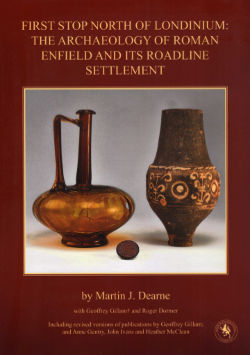
A definitive description and analysis of all the known Roman archaeology in the north London borough of Enfield, this monograph brings together antiquarian finds and re-presented and augmented reports on work from the 1950s to 1970s with the more recent excavations of the EAS as well as Museum of London Archaeology.
With prefatory chapters on aspects of the area including its prehistory, the volume documents what is known of the settlement that grew up here alongside Ermine Street, the road itself, a possible tannery, other settlement sites and often higher status burials.
A synthetic chapter examines the role of all small roadside settlements around Londinium in terms of function, chronology and their relationship to the provincial capital and discusses the possible economy of this area of the Lea valley.
With full illustrated stratigraphic and finds reports for over 45 individual sites (including samian ware, brooches, metalwork and important Roman glass finds), it presents the evidence for what may have been a broadly rural landscape, but with a quasi-urban settlement that may have reflected the needs of a cursus publicus system operating along one of the main roads of the province.
355 pages; 137 black and white and colour figures; 19 black and white and colour plates.
For delivery outside the UK, please contact research before ordering.
Alternatively, send a cheque payable to "The Enfield Archaeological Society" together with your postal address to:
Enfield Archaeological Society9 Junction Road
Edmonton
London
N9 7JS
Enfield At War: 1939-1945
Geoffrey Gillam & Ian Jones (Revised Edition, 2019)
£24.00 inc. p&p (uk delivery)
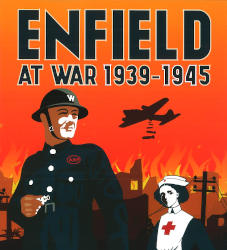
A detailed look at how the people of 3 districts, now one London borough, lived, worked and survived on the Home Front in the first conflict where civilians, including the youngest children, were as much at risk as those in the Forces.
229pp, over 650 illustrations in monochrome and colour.
For delivery outside the UK, please contact chairman before ordering.
Enfield At War: 1914-1918
Geoffrey Gillam & Ian Jones (Revised Edition, 2014)
£11.50 inc. p&p (uk delivery)
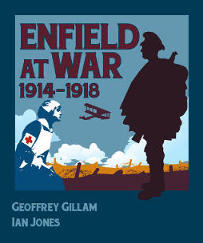
This greatly enlarged and lavishly illustrated new edition of the late Geoffrey Gillam's groundbreaking work, originally published in 1982, is being produced by the Enfield Archaeological Society in collaboration with the Enfield Museum Service to commemorate the beginning of the First World War.
For the first time the people of Enfield in common with the rest of the country were directly affected by a major war, which would change society in ways no-one could have imagined in 1914. Many thousands of young men went off to fight and thousands more returned wounded to the local hospitals, including Edmonton and Broomfield, for treatment. Their jobs were increasingly filled by women, especially in the huge munitions works like the Royal Small Arms Factory and the Ponders End Shell Works.
For the first time, civilians, men women and children, found themselves in the Front Line after air raids brought a new terror. As the war dragged on, shortages, rationing, conscription and the blackout affected people's lives. Thousands of families like the Sims of Ponders End and the Tuthills of Lancaster Road lost men and women to war, accident and disease while others suffered permanent disability.
For delivery outside the UK, please contact chairman before ordering.
Alternatively, download and complete this form and send, together with a cheque/postal order for the approprate amount to:
Ian K. Jones18 Corby Crescent
Enfield
Middlesex
EN2 7JT
EAS Occasional Research Notes
EAS Occasional Research Notes are free to download and are pdf format academic papers, usually by society members, which seek to disseminate research work connected to Enfield and adjoining areas which it is not convenient to publish in other formats or on other platforms. The series is edited by Dr. Martin Dearne; any queries or proposals for papers should be sent to him at research
EAS Occasional Research Note No. 1
The Roman ‘Roadline Settlement’ at Cheshunt Park Farm, Hertfordshire: A Review of the Evidence.